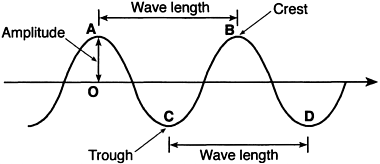169.
| [Cover] [Contents] [Index] |
Page 25
1.6 Radar fundamentals
An active radar system repetitively transmits short microwave energy pulses (normally of the order of microseconds, i.e. 10−6 second, denoted by μs) toward the area to be imaged. The energy pulse is likely to scatter in all directions when it reaches the surface. Part of the backscattered energy is reflected back to the radar antenna and recorded for later processing. Normally, each energy pulse has a duration of between 10 and 50 μs, and utilises a small range of microwave wavelengths. A waveform can be characterised in terms of its wavelength and amplitude. Wavelength is defined as the distance between two adjacent crests or troughs of the waves (Figure 1.12). Amplitude measures the strength of an electromagnetic wave in terms of the maximum distance achieved by the waveform relative to the mean position (shown by the horizontal line in Figure 1.12). The amplitude may be a function of a complex signal including both magnitude and the phase; this point is discussed further below.
Frequency, rather than wavelength, can also be used to describe wave-bands. Frequency is the number of oscillations per unit time or number of wavelengths that pass a point per unit time. One can obtain the frequency f (normally of the order of Gigahertz, GHz) corresponding to wavelength λ in terms of:
 |
(1.22) |
where c is the velocity of light (3×108 ms−1).
The description of radar operation in the following pages is based on the most widely used radar system installed on aircraft platforms, the side-looking airborne radar (SLAR). Space-borne imaging radars operate on a

Figure 1.12 Wavelength is the distance between two adjacent crests (e.g. A and B) or troughs (e.g. C and D). The amplitude of a waveform (distance AO) measures the ‘power’ or information carried by the wave.
| [Cover] [Contents] [Index] |
EAN: 2147483647
Pages: 354